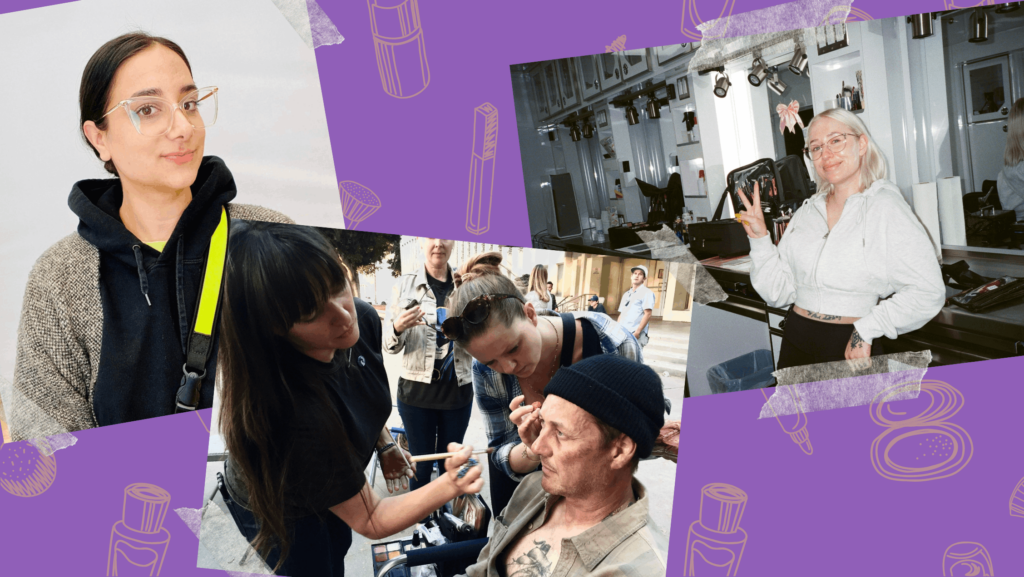Letting young people look like themselves should be a given, but this does not always happen in Hollywood. What we see on our screens are often unrealistic standards that do not align with everyday life. We spoke to makeup artists who have worked on films and TV shows including Abbott Elementary, Euphoria, Eighth Grade, Lady Bird, mid90s and Licorice Pizza about what it means to take a natural approach to teenage skin – flaws and all.
Emilia Werynska, makeup artist for the schoolchildren on Abbott Elementary, says that “99% of the time, there’s nothing a little moisturiser can’t fix.” This is their ethos for dealing with any “imperfections” that might arise on the faces of the primary to secondary school-aged actors on set. Dealing with skin at the beginning of puberty, where child actors might have bumps and blemishes for the very first time, Emilia compliments her department head, Alisha Baijounas, for prioritising authenticity by showing this; saying she is “very adamant on keeping kids look like kids, so it’s rare that they get the full makeup trailer experience.”
A new wave of shows about young people, especially Euphoria, portray skin differently, with a focus on bold, vivid eye looks that forces our obsession with smooth skin to take a backseat. “Euphoria-style makeup” has become a discernible subgenre in beauty trends, with this hashtag reaching 2.5bn views on TikTok, and Emilia, who has worked on season two the show, says “it’s very rare to work with a department head in TV that uses very minimal, sheer foundations and no powder whatsoever.” This moves the intention of TV makeup from covering up spots to experimenting with different designs and colours, which “has resonated with a whole generation and beyond.”
Is this mindset the start of a new generation of makeup artists committed to showing textured skin on young people? For Jacqueline Knowlton, it depends on the project. Jacqueline was head of the makeup department for Lady Bird, Licorice Pizza and mid90s – all coming of age films that have been praised for portraying a more realistic version of teenage-hood.
“I strive to create characters that are relatable and real,” she says. “I look at it from the standpoint of storytelling rather than trends.” When people say that there isn’t much makeup used in mid90s, Jacqueline is flattered more than anything. This is because it means that, “they weren’t distracted by the looks I designed.”
But this is not to say her looks have not had a real life impact. Lady Bird in particular left audiences astonished at the titular character’s (played by Saoirse Ronan) visible acne scars and blemished skin throughout. Saoirse’s embrace of her breakouts spurred thinkpieces, acne-centric articles and celebratory tweets. This was actually Jacqueline’s idea – she proposed they ditch the full coverage products to give Saoirse’s skin a break. “She had been working on a play and was wearing heavy makeup night after night, so we decided to let her natural skin show,” says Jacqueline.
“The younger generation seem way less embarrassed and happily embrace their bare faces to show off a pimple patch or acne, which I love so much”
Heidi Pakdel, makeup department head for the critically acclaimed film about an anxiety-ridden 13-year-old’s last week at school, Eighth Grade, was met with similar praise for her on-screen choices. She says that, five years later, people still tell her “how much they loved the movie and makeup”. After discussions with director Bo Burnham, Heidi opted to use very little makeup, especially for the main character Kayla (played by Elsie Fisher). “We wanted it to be raw and really represent what real life teenagers look like. It sends a positive message that it is a very normal part of life to have acne or flaws,” she says.
Eighth Grade is frequently praised for this on social media, with one user tweeting, “As someone with lifelong, chronically bad skin it is my belief that Elsie Fisher and Saoirse Ronan should get as much attention for filming with their real acne as Oldman and Bale did for getting made up to look like old jowly white guys”. Heidi believes change is definitely in the air. “The younger generation seem way less embarrassed and happily embrace their bare faces to show off a pimple patch or acne, which I love so much.”
Emilia thinks our fascination with airbrushed skin boils down to technology that revolutionised makeup application because our “imperfections” became high definition. “Cameras in the nineties and early noughties didn’t even leave room for you to consider if an actor was struggling with acne or not because you couldn’t see the texture of their skin to begin with”, she says. “Once HD came into the picture, people fell into a panic and wanted to make sure everything looked as perfect as possible by piling on products to make things as smooth as they used to be.” The lack of social media also limited our discussions. “No one really talked about their acne or skin issues because aside from commercials for shitty drug store products, we didn’t really know how to deal with it.”
Film and TV is evolving, and the wants of the audience are now aligning with actors, “we’ve finally reached a time in entertainment when viewers want to see more faces that look resemble them, and on the opposite side of the screen, actors are more comfortable being that kind of role model to their fans” she says. With a legion of young people who are using social media to relate to each other and normalise their imperfections, Emilia calls this a “revolution that is amazing to witness”.
Pictures: Heidi Pakdel, Jacqueline Knowlton, Emilia Werynska by Jon Bass

